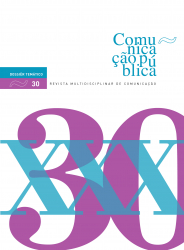O Living Lab on Media Content and Platforms
Resultados de seis meses de web browser tracking
DOI:
https://doi.org/10.4000/cp.12665Resumo
O Living Lab on Media Content and Platforms (LLMCP) desenvolveu o projeto LLMCP LisPan, com o objetivo de estudar hábitos e comportamentos dos utilizadores da Internet, através de um inovador painel online de utilizadores com recurso a tecnologia de web tracking. Foi possível analisar o comportamento online efetivo de um painel de 70 alunos do ensino superior, durante seis meses, e comparar essa análise com as respostas a um inquérito por questionário, para a mesma amostra. Os resultados confirmam o uso extensivo da Internet, mas com diferenças entre sexta, sábado e domingo, em relação ao resto da semana, e a existência de períodos de intensidade diferente, ao longo do dia. Foram, também, encontradas diferenças entre uma dimensão “online” de utilização da Internet (pesquisa e utilização de conteúdo online) e uma dimensão “conectada” (interação online com outros utilizadores). Foi, ainda, possível concluir que três quartos dos participantes sobre-estimam a frequência do seu acesso à Internet.
Downloads
Referências
Adar, E., Teevan, J., & Dumais, S. T. (2009). Resonance on the web: Web dynamics and revisitation patterns. In D.R. Olsen & R.B. Arthur (Eds.), CHI '09: Proceedings of the SIGCHI Conference on Human Factors in Computing Systems (pp. 1381-1390), Association for Computing Machinery. https://doi.org/10.1145/1518701.1518909.
DOI : 10.1145/1518701.1518909
Banaji, S., Livingstone, S., Nandi, A., & Stoilova, M. (2018). Instrumentalising the digital: adolescents’ engagement with ICTs in low-and middle-income countries. Development in Practice, 28(3), 432-443. https://doi.org/10.1080/09614524.2018.1438366
DOI : 10.1080/09614524.2018.1438366
Blank, G., & Lutz, C. (2017). Representativeness of social media in Great Britain: Investigating Facebook, LinkedIn, Twitter, Pinterest, Google+, and Instagram, American Behavioral Scientist, 61(7) 1–16. https://doi.org/10.1177/0002764217717559
DOI : 10.1177/0002764217717559
Bilenko, M. & White, R. (2008). Mining the search trails of surfing crowds: Identifying relevant websites from user activity. In J. Huai & R. Chen (Eds.), Proceedings of the WWW 2008 - World Wide Web Conference (pp. 51-60). Association for Computing Machinery. https://doi.org/10.1145/1367497.1367505
DOI : 10.1145/1367497.1367505
Castells, M. (2001). The internet galaxy: Reflections on the internet, business, and society. Oxford University Press.
Foddy, W. (1993). Constructing questions for interviews and questionnaires - Theory and practice in social research. Cambridge University Press.
DOI : 10.1016/S0031-9406(10)61110-8
Hargittai, E., & Shaw, A. (2020). Comparing internet experiences and prosociality in Amazon Mechanical Turk and Population-Based Survey Samples. Socius: Sociological Research for a Dynamic World, 6, 1–11. https://doi.org/10.1177/2378023119889834
DOI : 10.1177/2378023119889834
Hunsaker, A., Hargittai, E., & Piper, A. M. (2020). Online social connectedness and anxiety among older adults, International Journal of Communication, 14, 697–725. https://doi.org/10.5167/uzh-186376
DOI : 10.5167/uzh-186376
Kumar, R., & Tomkins. A. (2010). A characterization of online browsing behavior. In ;- Rappa, P. Jones, J. Freire, & S. Chakrabarti (Eds.), Proceedings of the WWW 2010 - World Wide Web Conference (pp. 561-570). Association for Computing Machinery. https://doi.org/10.1145/1772690.1772748
DOI : 10.1145/1772690.1772748
LaPiere, R.T. (1934). Attitudes vs. actions, Social Forces, 13(29), 230-237.
DOI : 10.2307/2570339
Latzer, M., Büchi, M., & Festic, N. (2020). Internet use in Switzerland 2011–2019: Trends, attitudes and effects, Summary Report from the World Internet Project – Switzerland. University of Zurich. http://mediachange.ch/research/wip-ch-2019
Louro, C., Carvalhosa, D., Leonardo, J., Sousa, R., Ferreira, P.C., & Souza, S.B. (2020). Automutilação digital: um estudo exploratório com universitários portugueses, Revista Ambiente Educação, 13(1), 15-30. https://doi.org/10.26843/ae19828632v13n12020p15a30
DOI : 10.26843/ae19828632v13n12020p15a30
Montargil, F., Di Fátima, B., Rodrigues, V., & Santos, V. (2019). Medir a sociedade de informação: Sistema para um painel online de utilizadores da Internet. CISTI (Ed.), 14th Iberian Conference on Information Systems and Technologies (pp-1-4). AISTI. DOI: 10.23919/CISTI.2019.8760838
DOI : 10.23919/CISTI.2019.8760838
Montargil, F., Di Fátima, B., & Ruiz, C. (2020). Building a web tracking browser information system: The online panel as a research method in internet studies. In A. Rocha, C. Ferrás, C. Montenegro Marin, & V. Medina García (eds) (Eds), Information Technology and Systems. ICITS 2020. Advances in Intelligent Systems and Computing, vol 1137 (pp. 449-455). Springer. DOI: https://doi.org/10.1007/978-3-030-40690-5_44.
DOI : 10.1007/978-3-030-40690-5_44
Murdock, K. K. (2013). Texting while stressed: Implications for students’ burnout, sleep, and well-being, Psychology of Popular Media Culture, 2(4), 207–221. https://doi.org/10.1037/ppm0000012
DOI : 10.1037/ppm0000012
Pew Research Center (2018). Social media use in 2018. https://www.pewresearch.org/internet/2018/03/01/social-media-use-in-2018/#:~:text=A%20new%20Pew%20Research%20Center,trends%20and%20newly%20emerging%20narratives.&text=Similarly%2C%2071%25%20of%20Americans%20in,45%25)%20are%20Twitter%20users
Reich, S., & Vorderer, P. (2013). Individual differences in need to belong in users of social networking sites. In P. Moy (Ed.), Communication and community (pp. 129-148). Hampton Press.
Reinecke, L., Klimmt, C., Meier, A., Reich, S., Hefner, D., Knop-Huelss, K., … Vorderer, P. (2018). Permanently online and permanently connected: Development and validation of the Online Vigilance Scale. PLoS ONE 13(10), e0205384. https://doi.org/10.1371/journal.pone.0205384
DOI : 10.1371/journal.pone.0205384
Revilla, M., Ochoa, C., & Loewe, G. (2016). Using passive data from a meter to complement survey data in order to study online behavior. Social Science Computer Review, 35(4), 521–536. https://doi.org/10.1177/0894439316638457
DOI : 10.1177/0894439316638457
Smahel, D., Machackova, H., Mascheroni, G., Dedkova, L., Staksrud, E., Ólafsson, K., …Hasebrink, U. (2020). EU Kids online 2020: Survey results from 19 countries. London School of Economics and Political Science.
Statcounter (2018). Top desktop, tablet & console browsers per country. Global Stats Tool.
Trindade, G., & Duarte, A. (2019). Comparing the consumption of musical and films online between generations X and Y in Portugal and Spain. 2019 14th Iberian Conference on Information Systems and Technologies (CISTI), Coimbra, Portugal, pp. 1-6.
Vorderer, P., Krõmer, N., & Schneider, F. M. (2016). Permanently online and permanently connected: Explorations into university students’ use of social media and mobile smart devices. Computers in Human Behavior 63, 694-703. http://dx.doi.org/10.1016/j.chb.2016.05.085.
DOI : 10.1016/j.chb.2016.05.085
Vorderer, P., Hefner, D., Reinecke, L., & Klimmt, C. (Eds.). (2018). Permanently online, permanently connected. Living and communicating in a POPC world. Routledge.
Downloads
Publicado
Edição
Secção
Licença
Direitos de Autor (c) 2021 Copyright (c) 2021

Este trabalho encontra-se publicado com a Licença Internacional Creative Commons Atribuição-NãoComercial 4.0.
Os conteúdos da Comunicação Pública estão licenciados com uma licença Creative Commons - Atribuição-NãoComercial 4.0 Internacional.




